19 years have gone by since I acquired my Majacraft Rose. I had spun on a drop spindle for about 6 months before I got my Rose, using wool from our starter flock of shetland sheep we acquired in August of 2008. Our starter flock consisted of four ewes - Myrtle was grey, Marigold was black, Petunia was Moorit and Daisy was white. We had a fawn ram, I can't remember his name.
This is a photo of the starter flock, in our postage stamp back yard. Our property ended where the fenceline is, we were on a 1 acre lot.
I remember going to Raveloe fibers in Niagara Falls to an evening spin where I was given a spindle and some white merino to try my hand at spindling for the first time ever! The photo below is the spindle I started with. Unfortunately, I don't know what happened to the first spin, it is camouflaged in with a bin of old singles from when I was first practicing.
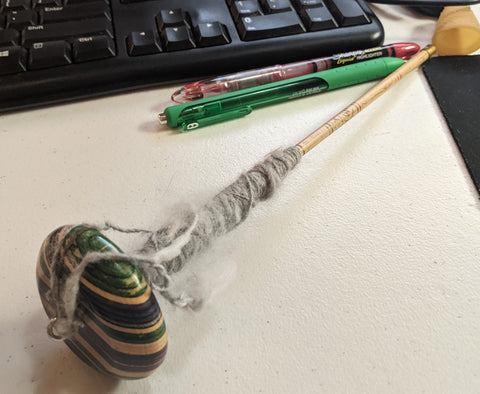
I bought a flick carder based on a recommendation from a fellow shetland sheep breeder and I was on my way. This is the style I started with, I burned thru about 1 per year until I started using the Majacraft flicker, which is still working fine after 3 years!

I got my Rose as a Christmas present, Rich had done all the sourcing and surprised me with it on Christmas morning. I don't remember assembling it, but I do remember the very first time I used it with some wool from my sheep and I felt like I was flying, it was so easy compared to the drop spindle.
I didn't realize all the accessories and options that were available at that time. YouTube didn't exist if you can believe it, (How did we learn about things back then?). So I spun with the large whorl and delta flyer for the first 19 years until I started my Majacraft Dealership and began to learn all about the other options and ways to optimize my wheel for different types of spinning yarn.
I've been creating a series of videos on my YouTube Channel on each wheel demonstrating the different phases of ownership - from unboxing to using and then trying each accessory with a video dedicated to each. I thought it would be fun to do a piece that compares the contemporary Rose with my 2002 Vintage rose, for those who are curious about what has changed over those 20 years.
It is a happy miracle that I saved all the paperwork from the original purchase, and also know exactly where the paperwork is so I can verify date of purchase and enjoy reading all the documentation that was sent with my wheel. Starting in the upper right corner there is the inspection checklist, then clockwise around a Rose assembly manual, a registration card, an announcement about a spinning contest, a flyer that promotes accessories (I don't remember ever even looking at it), and a spinning manual.

Today most of this material can be downloaded from the web, but they still send a paper spinning and assembly manual with your new wheel.

Rich bought it from Woolly Designs when they were in Colorodo. They are now in Texas, but their site is a little out of date, so I am not sure how active they are. Their website still exists and from time to time I review it as they put a lot of work into providing content about the Majacraft wheels to us spinners. The date on the folder says December 14, 2002, so I guess technically I've owned the wheel for 19 years. As I review the paperwork that came with my wheel I am amazed at the additional detail the dealer provided about assembly, tips and tricks. Photo below is the additional material that the dealer sent along with the wheel. I guess we use YouTube and blogs for this type of information now.

So below I am going to show you the upgrades that Majacraft made when announcing the new Rose in April of 2011. Some of the mods are purely aesthetic, while others are functional changes. If you have a pre April 2011 rose, you should make that clear to your dealer when you are ordering any replacement parts. Parts for the old design are available, but the Majacraft team assumes new design unless they are specifically notified that the wheel is pre - 4/2011.
In all the photo pairings below, the 2002 wheel is on the left, and the 2021 wheel is on the right.
Smoother head design
Photo on left shows the head was built in sections, with sharp angles where it is inserted into the stem. 2021 Rose has a one piece handcrafted head with much more elegant lines.

JCB bolts used in the handle
I noticed that wherever it was possible to switch from traditional hardware to JCB Bolts, it was incorporated into the new design. JCB bolts make assembly much easier, and also make it possible to disassemble and assemble many times without causing damage to the wheel. This is because you aren't screwing directly into the wood with wood screws. Rather you are screwing into a threaded insert which can handle multiple assemblies without wearing out the wood.


New Rose motif
Changed the decoration from carved, to some sort of etched technique. I like both, do you have a preference?


10mm stainless steel shaft on the drive axle
I decided I didn't want to disassemble both wheels to show you the shaft used. This is an important change if you are rebuilding an old wheel, or looking for parts. It is very important if you have a pre upgrade wheel that you let your supplier know when ordering replacement drive wheel or shaft. Wheels before 4/2011 use an 8 mm drive shaft. The new wheel uses a 10 mm drive shaft. This was changed to improve the strength of the drive shaft. Upgrading to the 10 mm drive shaft is an option if you have an older wheel.
New base design
In my eyes they are different, one isn't any better than the other. If there is a benefit other than aesthetic, it isn't obvious to me. This is really bad, but sometimes I treadle with one foot and rest the other foot on that center piece. So I guess its good the new design doesn't look as if it will work as a good footrest, cause that can't be good for the wheel!

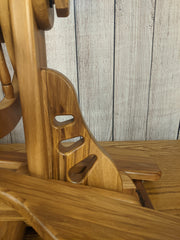
New pedal design
The new pedal has more design to it, older pedal is pretty much just a square shape, very utilitarian looking in my opinion vs the new design which is more sexy.
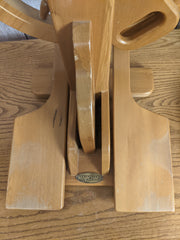

JCB bolts in the base
When you thread in the JCB bolts with new design, the bolt is going into a threaded insert, vs driving thru the wood, so better if you are assembling and disassembling frequently. Also makes it easier to assemble.


Majacraft stainless steel hinges
Stainless steel is an upgrade, and there are more screws for better strength and quality.


Low profile handle nut
I am not sure if this is any more than aesthetic with this change.


Handle stop on new
This is definitely an upgrade. When you tilt the handle on the old Rose, nothing prevents you from banging the head against the treadles, which can damage both parts. The new Rose has a built in stop that prevents the head from coming any where near the treadles. In the photos below, the stems are tilted to their full extension, with the old Rose the tension knob on the head is touching the treadle. V. good idea to remedy this.


Flyer shape
Old flyer (in background) has silver flyer rods, and a square shaped flyer bar. Also, it doesn't have a ceramic lined orifice on the standard flyer while the new standard flyer has a ceramic orifice. This is an upgrade as the ceramic lining prevents you from wearing a groove thru the unprotected orifice, which I did, and am unable to use it because the fiber gets caught up in the sharp groove I've worn into it.

Bobbin holder
Old bobbin holder is a box, with a pretty rose carved on side. 3 bars come with it so you can use it as a lazy kate if you don't need tension. The two holes on the opposite sides were intended for use to install a home made handle of string or something. I never used that feature. New bobbin holder is featured in the photo below. I love the magnet for the wrench, and the little peg to hold the whorl. I think my old box works better as a lazy kate.
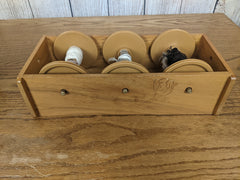

Metal plate vs engraving
Hmm. Struggling with this because I really prefer the metal plate, but I get the fact that the engraving probably is more efficient.


Crank assembly attachment
This is important for those restoring old wheels. Make sure you notify your supplier that you have an old wheel. The old crank assembly is attached to the drive wheel with wood screws driving directly into the wood. New crank assembly has jcb bolts joined into threaded inserts. If you like to change your drive band by removing the crank assembly, then the new Rose is a better design. I change my drive band by disconnecting the rubber joiners from the treadles, as that is how it is recommended by Majacraft. The green rubber joiners that receive the wood screw are easy to replace if they get worn. I've changed my drive band 4 times (Stupid cat) and am still using original green rubber joiners.
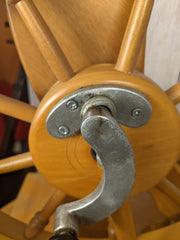

Wood used
I thought my old Rose was made of Maple, but I confirmed with the factory that it is made from the same material as is used today. Which I find really interesting and wonder if it yellowed with age, or the trees were different 20 years ago, or it was just that lot of lumber. So anyways, the Rose is made from sustainably harvested Rimu wood, indigenous to the forests of New Zealand.
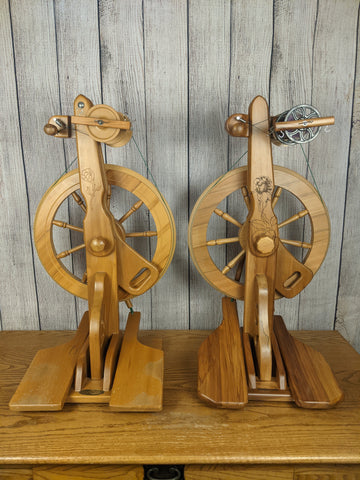
Overdrive Head Accommodation
The old rose is missing the deep groove on the largest whorl of the drive wheel. This was added when the Overdrive Head was released to hold the brake band more securely. If you have an old Rose and want to use the Overdrive head, you can request that your old wheel get remachined. Or you can take your chances that the brake band will work just fine.


In Conclusion
Someone asked me recently if there are any issues with sticking with their old Rose with all the new accessories and spares that have been launched since the Rose came out in 1997 (!). All of the accessories offered today by Majacraft can be used on my vintage Rose wheel. So I would say as long as you are clear with your supplier that you have an older vintage Rose, you will continue to be supported and can continue to use your old Rose to spin your dreams!!!



1 comment:
Thanks for this comparison of old/new Rose. Mine is definitely old (1998) and always am wondering if the new accessories will work on it. Now I know I can just ask Jen.
Arlie
Post a Comment